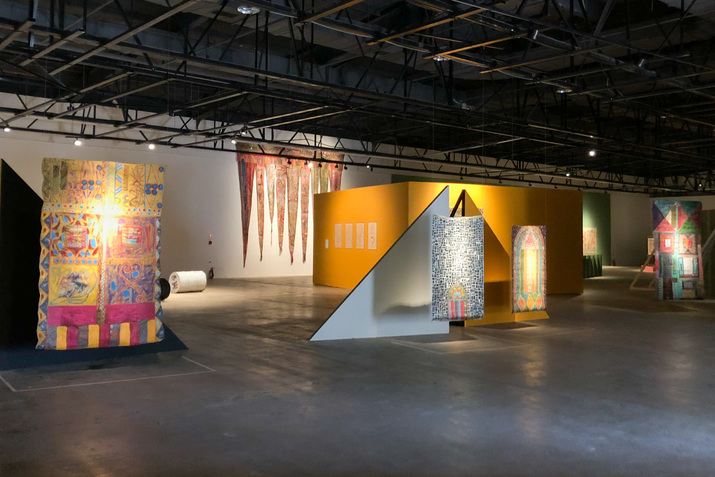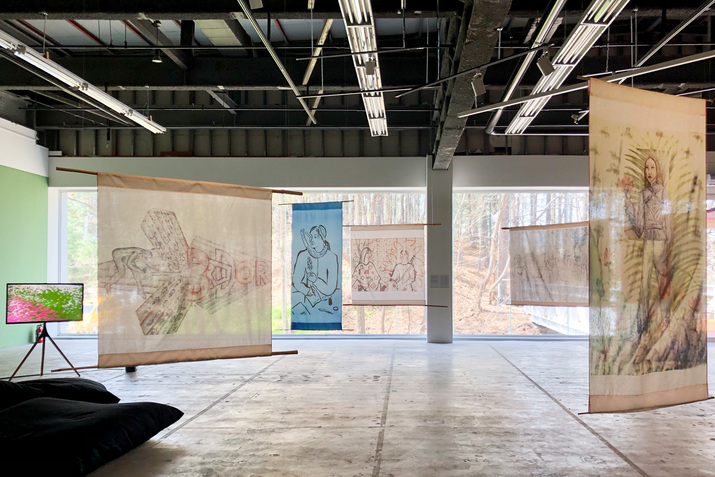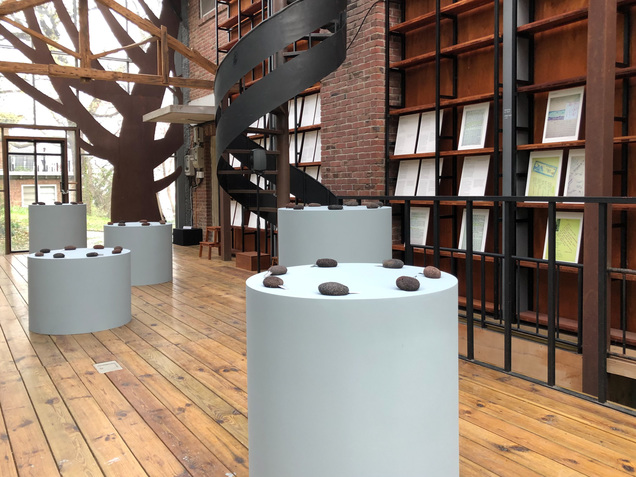Highlights from the 13th Gwangju Biennale: “Minds Rising, Spirits Tuning”
By Andy St. Louis

Installation view of ANGELO PLESSAS’s The Noospheric Society, 2021, multimedia installation, dimensions variable, at the 13th Gwangju Biennale, 2021. All photos by Andy St. Louis for ArtAsiaPacific.
After two postponements, the 13th Gwangju Biennale finally opened its doors to the public on April 1. Notably absent from the affair was any of the pageantry that typically accompanies the vernissage of Asia’s longest-running biennial—gone were the public programs and afterparties of the pre-pandemic era—which resulted in a rather subdued opening weekend. Notwithstanding, the exhibition itself offered viewers plenty of food for thought, with a spate of new commissions and a diverse lineup of participating artists. Helming this endeavor were artistic directors Defne Ayas and Natasha Ginwala, who assembled works by 69 artists from 40 countries to broadly explore the nature of intelligence under the guiding theme of “Minds Rising, Spirits Tuning.” This discursive purview sought to probe the spectrum of the extended mind, reconciling realms of spirituality, technology, and ecology with an emphasis on heterodox and communal systems of knowledge.
The exhibition unfolded across five galleries of the main Gwangju Biennale Exhibition Hall, as well as off-site venues including the state-run Gwangju National Museum, historic Gwangju Theater, and alternative art space Horangassy Artpolygon. Textile-based works were abundant throughout, with prominent contributions by Moon Kyungwon, Pacita Abad, Cecilia Vicuña, and Angelo Plessas that engaged aspects of social history and solidarity in the context of localized trauma and healing practices. In keeping with the curatorial mandate to expand notions of intelligence into the collective memory of marginalized communities and sources of ancestral wisdom, an archival sensibility informed immersive installations by Kang Seung Lee, Vaginal Davis, Femke Herregraven, and Sissel Tolaas. A relative dearth of video works was offset by the strength of commissions by Korakrit Arunanondchai, Judy Radul, Theo Eshetu, and Sylbee Kim, ensuring an exceptional slate of media art offerings. Throughout the exhibition, selections of images, objects, and relics from the Seoul-based Gahoe Minhwa Collection and The Museum of Shamanism rooted the exhibition’s inquiry in a context germane to local audiences by layering the visual vocabularies of Korean folk traditions alongside contemporary artworks.

Installation view of works by PACITA ABAD at the 13th Gwangju Biennale.

CECILIA VICUNA‘s works, pictured with ANA MARIA MILLAN’s Happy People, 2020, video game, workshop.

KANG SEUNG LEE’s project for the 13th Gwangju Biennale.

VAGINAL DAVIS, Club Sucker, 1990s/2021, original and facsimile photographs, fanzines and other multiples, letters, collages, sound, dimensions variable.

SISSEL TOLAAS, EQ_IQ_EQ,
2019- , 37 volcanic pumice stones, 37 smell codes embedded in stones,
diary entries by Yang Sinha (1948-2020); soundscape: paralinguistic
sounds, emotional intelligence (EQ) database, dimensions variable.
For the first time in Gwangju Biennale’s 25-year history, a portion of the main exhibition hall was designated free and open to the public, offering a succinct preview for the remainder of the ticketed displays. It was also intended to serve as the ceremonial ground for an elaborate procession, “Through the Gates,” that was set to coincide with the exhibition opening, incorporating artworks, objects, and performances by a number of the biennial’s participating artists; in the end, this ambitious live event was scaled back and pre-recorded due to Covid-19-related concerns. While the pandemic certainly put a damper on this year’s biennial, it also allowed organizers to focus on establishing a curatorial imperative that remained vitally in touch with the realities of these uncertain times. In challenging dominant narratives of anthropogenic supremacy, technocratic hegemony, and dogmatic authoritarianism, “Minds Rising, Spirits Tuning” presented a compelling treatise on alternate modalities of knowledge that arise from a more syncretic paradigm of spiritual and cerebral consciousness.

KORAKRIT ARUNANONDCHAI, Songs for Dying, 2021, single-channel video, color, sound, painting: 30 min 18 sec.

JUDY RADUL, Warmer Than the World Around Us, 2021, two-channel video installation with LED panels: approx. 25 min

THEO ESHETU, Ghostdance, 2020, single-channel video, color, sound: 18 min

Knife-Riding Guardian God, 20th century, Gahoe Minhwa Museum collection.
Andy St. Louis is ArtAsiaPacific’s Seoul desk editor.
The 13th Gwangju Biennale, “Minds Rising, Spirits Tuning,” is on view at multiple locations until May 9, 2021.







